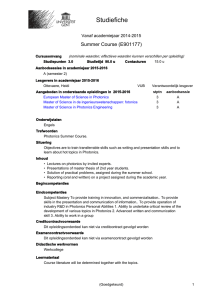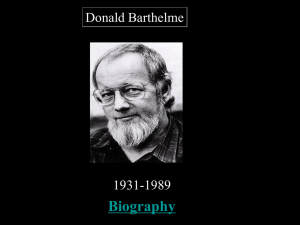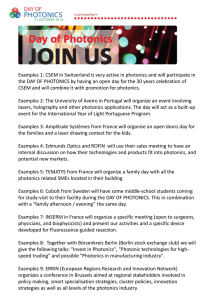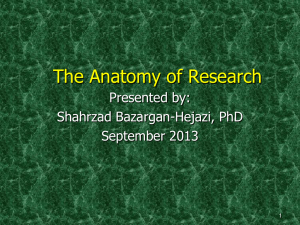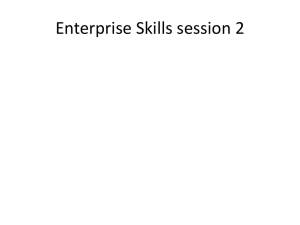Project: DAS photonics - Universidad Politécnica de Valencia
advertisement
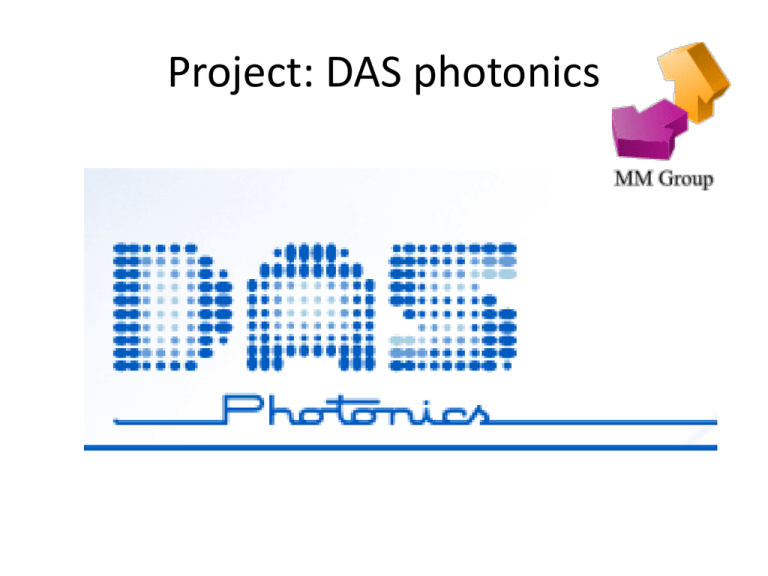
Project: DAS photonics Description of the company • What does it do? DAS Photonics S.L. is a spin-off company from the Valencia Nanophotonics Tecnology Center (NTC), Universidad Politécnica de Valencia, whose mission is to exert the European leadership in photonic technology and system development in the areas of: • • • • Defense and Security Avionics Satellite Telecommunications Description of the company • Localisation : Description of the company • History: “Market needs products…Not only base technologies” Javier Martí in 2005 Description of the company • History: Why don´t create a new company? Description of the company • History: Then they started to offer real solutions to technological problems. Description of the company • Objectives: To offer photonic devices and systems that massive production companies don´t design Why ? Because they can´t offer such low prices as them Description of the company • What can photonic devices offer us? Weigh Size Speed Power needs Works and services offered to clients 1.Digital Receivers Based on proprietary photonic technology, high performance Digital Receivers developed at DAS Photonics go far beyond the performance of their electronic counterparts in terms of bandwidth, dynamic range, … These devices offer extremely interesting applications, especially in the fields of electronic warfare and next-generation Ultra Wide Band (UWB) networks. Works and services offered to clients 2.Optical Beamforming Optical beamforming networks for phased-array antennas that exploit advantages of photonic technology (such as large bandwidth, fast beam switching, low size and weight, low power consumption, immunity to EMI and high parallelism) to dynamically reconfigure their radiation patterns. Several prototypes (hybrid and integrated) have been developed, based on optical delay lines and photonic integrated devices. This kind of antennas is extremely attractive for satellite applications, as well as for high-resolution radar systems. Works and services offered to clients 3.Radio-over-fiber links for remote antennas High-performance optical links (high SFDR, low loss, large bandwidth) for interconnecting: •central and remote units in radar systems and electronic warfare receivers •central stations and base stations for the distibution of microwave signals (WiMAX, UMTS,...) in telecomunication access networks These optical-fibre links soften the localization requirements of the radiating elements and processing and frequency-converting systems, so that the optical fibre transports the signals on the frequency bands that are received (or transmitted) directly from the antennas. Their main application fieds are telecom, highresolution radar systems and electronic warfare. Works and services offered to clients 4.Photonic nanostructures Specific designs of nanostructures manufactured on diverse materials (semiconductors, polymers, metals,…) for applications of wavelength filtering, slow waves, high-dispersive elements, coupling optimization and adaptation of refractive indexes,… These nanostructures are of special interest for optical sensors and photonic processing devices. Works and services offered to clients 5.High-performance telecommunication systems and devices Innovative cutting-edge-technology systems and devices oriented towards telecommunication applications, both at the core network and the access segment. Our designs encompass products at system level as well as the fabrication of components and devices for third-party products, through extensive expertise on fields such as microwave photonics, high-speed optical processing and micro/nanofabrication technologies and processes. Works and services offered to clients 6.Optical Interconnects DAS Photonics develops optical solutions for interconnecting electronic systems at very high speed, based on different photonic technologies, oriented towards multiple application scenarios (board-to-board, system-to-system,…). Advanced computing, storage networks, or space systems are examples of the wide range of applications targeted by these Optical Interconnect technologies. Description of the company • Organization structure: TOTAL:30 people Director : Javier Marti 3 divisions Defense + Operation responsible + Technology Operator Avionics Satelites Description of the company • Competitors: Selex (Italy) + Thales (France) 10 Operations Management Decisions • Let's see how the company works: Goods & service design • • • • Das photonics works in the conception of components to deliver to clients (which are not commoncustomers but companies). These components are used for defense, satelites and other very high level telecommunication areas. For that reason, they have to be to design the smallest possible and their weight is to be the lightest possible. Most of the time, light is used to vehicule this information. (light has no weight!) Quality • Quality is the top priority of Das phontonics. • The reason is simple, not only has the customer to be satisfied, but also any small error could lead to the malfunction of the component. • Due to the sectors in which das photonics works, which are defense, security and fibre transmission, the quality is of the upmost importance. Process & capacity design • • The company is still growing actually.But due to its recent creation, process and capacity design are still evolving and not really longterm situations at the moment. This year: 1 Mi € Yet, different areas have their proper scientist. An interview of one of them enlighted this question: – The company works with a perpendicualar system. Imagine two rows, one vertical and horizontal. One is of the decisions and the other of technologies. The intersection of them makes the company works. Location selection • The company is located in the best area of Valencia, in Spain. • They are in the university of polytechnica of Valencia and linked to some other nanotechnology companies. • As it is growing, recruting some potencial and talented new workers is also a priority. And students as of those from Teleco are first choices. Layout design • The layout design has not changed since the begining and can be a subject of interest. • The blue color evocates the future and technologies. • The design of their website is clear and easy to use. As their components have to be. • Futhermore, their name Das Photonics is enough to guess that they are working on light use, the area of future. Human resource and job design • Starting firts with 5 people as a project, Das photonics has suceeded in growing quickly. • In only 3 years (from 2005 to 2008), more than 20 people have arrived. All qualified and young and dynamic. Supply-chain management • Das Photonics is its own distributor • Yet It also uses its link with the nanotechnologic center to create new contracts Inventory • Das photonics does not need a lot of raw materials: Their components have to be small and the lightest possible. • As a consequence, veryprecise robots, of the area of the nanotechnlogy, are needed and are furnished by Spain. • Optical systems to transport light among materials are also important. Scheduling • This is the strong point of Das Photonics. • Using its perpendicular system, projects are created, proposed and accepted. • Their high investment in R&D allows them to make some discoveries, and to propose them in the correct area. • An example is the discovering of invisible materials which can be used in defense. Maintenance • Maintenance is not a problem for das photonics. • On the left hand, they are evolving very importantly and they keep getting bigger. They received a price for "Emprededor en Telcos" last year. • On the other hand, their investment in R&D is going higher every year and shows how powerful this company is getting. Quality Tools Brainstorming & Ishikawa diagram Quality Tools The most useful tools are: 1. Brainstorming 2. The Ishikawa diagram (or fishbone diagram or also cause-and-effect diagram) Quality Tools 1. Brainstorming 1. 2. Is a group creativity technique designed to generate a large number of ideas for the solution to a problem. The method was first popularized in the late 1930s by Alex Faickney Osborn, an advertising executive and one of the founders of BBDO, in a book called Applied Imagination. Osborn proposed that groups could double their creative output by using the method of brainstorming. Is widely used, but there is limited agreement on the detail of how it is to be done. The name is often used for a general collection of thoughts within a group, whether it is creative or simple collation of known facts. Selection, often through Voting, is also often considered to be a part of Brainstorming. Quality Tools 1. Brainstorming a) Useful situationes: • when new ideas are required, to generate a large list of possibilities, • when a solution to a problem cannot be logically deduced, • when information about a problem is confused and spread across several people, to gather the information in one place • The creative synergy of a Brainstorming session is also useful in helping a team bind together Quality Tools 1. Brainstorming b) Steps of using brainstorm: • • • • • • Start with a clear and open statement of the problem that you want to address. Appoint a facilitator to organize and run the Brainstorming meeting. Look for a person who is skilled in facilitating, who has no strong opinions about the problem and who the potential Brainstorming group will respect in that role. If possible, also appoint a recorder. Form a group of between five and eight people who may contribute to the problem. Look for complementary, rather than supplementary knowledge, to allow for the broadest range of inputs. Try to avoid including people who may antagonize or inhibit one another. Lay out the meeting room with participants facing one wall, on which is a whiteboard or flipchart. In the meeting, the facilitator focuses the group by describing the four rules of Brainstorming ( No criticism or debate, The sky is the limit, Quantity rather than quality, Mutate and combine), Start generating ideas, making sure that everyone can contribute. Quality Tools 1. Brainstorming b) Steps of using brainstorm: • • • • As the ideas are suggested, the recorder writes each one down on the whiteboard or flipchart, so that they are all in full view of the participants. Ways to regenerate flagging ideas include: – Build a private list of ideas beforehand, and dip into it when ideas run out or get stuck in a rut. – Stop for a while, and just look at the ideas generated so far. – Take a break. Rest the mind. – Have a 'wild idea' session, where the main objective is to come up with outlandish ideas. – Improve on promising ideas by talking about, 'What I like about this idea ... '. – Use one or more of the variations, below. When there are no more ideas to add, discuss the listed ideas, looking to identify the better ideas rather than eliminating those which are not so good. The ideas can be reviewed in the light of known constraints, such as time and cost, again looking positively for how they can be used within these constraints. If there is no clear agreement on the best idea, or if there is any chance of participants being reticent, identify a voting system to decide Quality Tools 1. Brainstorming c) Process of conducting a brainstorming session: Quality Tools 1. Brainstorming d) Conclusion: Brainstorming is a popular method of group interaction in both educational and business settings. Although it does not appear to provide a measurable advantage in creative output, brainstorming is an enjoyable exercise that is typically well received by participants. Newer variations of brainstorming seek to overcome barriers like production blocking and may well prove superior to the original technique. How well these newer methods work, and whether or not they should still be classified as brainstorming, are questions that require further research before they can be answered. Quality Tools 2. The Ishikawa diagram The cause-and-effect diagram is : • • a method for analysing process dispersion. The diagram's purpose is to relate causes and effects. Three basic types: Dispersion analysis, Process classification and cause enumeration. Effect = problem to be resolved, opportunity to be grasped, result to be achieved. Excellent for capturing team brainstorming output and for filling in from the 'wide picture'. Helps organise and relate factors, providing a sequential view. Deals with time direction but not quantity. Can become very complex. Can be difficult to identify or demonstrate interrelationships. the brainchild of Kaoru Ishikawa, who pioneered quality management processes in the Kawasaki shipyards, and in the process became one of the founding fathers of modern management. The cause and effect diagram is used to explore all the potential or real causes (or inputs) that result in a single effect (or output). Causes are arranged according to their level of importance or detail, resulting in a depiction of relationships and hierarchy of events. This can help you search for root causes, identify areas where there may be problems, and compare the relative importance of different causes. Quality Tools 2. The Ishikawa diagram a) Appearance: Most Ishikawa diagrams have a box at the right hand side in which is written the effect that is to be examined. The main body of the diagram is a horizontal line from which stem the general causes, represented as "bones". These are drawn towards the left-hand side of the paper and are each labeled with the causes to be investigated, often brainstormed beforehand and based on the major causes listed above. Off each of the large bones there may be smaller bones highlighting more specific aspects of a certain cause, and sometimes there may be a third level of bones or more. These can be found using the '5 Whys' technique. When the most probable causes have been identified, they are written in the box along with the original effect. The more populated bones generally outline more influential factors, with the opposite applying to bones with fewer "branches". Further analysis of the diagram can be achieved with a Pareto chart. Quality Tools 2. The Ishikawa diagram Quality Tools 2. The Ishikawa diagram b) Useful when: • investigating a problem, to identify and select key problem causes to investigate or address, • the primary symptom (or effect) of a problem is known, but possible causes are not all clear, • working in a group, to gain a common understanding of problem causes and their relationship, • we want to find other causal relationships, such as potential risks or causes of desired effects, • in preference to a Relations Diagram where there is one problem and causes are mostly hierarchical (this will be most cases). Quality Tools 2. The Ishikawa diagram c) Steps of introducing: • • • Form a small team of people to work on the problem. Ideally, their knowledge and skills will be complementary, to give a broad but expert group. If it has not been already defined, meet first to define the key symptom or effect of the problem under scrutiny. Aim for a brief, clear phrase which describes what is happening to what, such as, 'Low sales of MkII Costor'. Make sure that only a single effect is described, as this may result in several sets of causes. Write down the key effect or symptom at the center-right of the page (or whiteboard or flipchart, if you are doing it in a group), and draw a spine horizontally from it to the left. Draw the main cause area 'ribs' (typically around four to six), one for each of what appears to be the primary cause areas. If these are uncertain, then the 'Four Ms' (Manpower, Methods, Machines and Materials) provide a good starting point, as illustrated in Fig. 1. In these gender-free days, an exact alternative is the four Ps (People, Processes, Plant and Parts). Quality Tools 2. The Ishikawa diagram c) Steps of introducing: • • • • • • • • • Use Brainstorming to build the diagram, adding causes or cause areas to the appropriate ribs or sub-ribs as they appear. If a cause appears in several places, show the linkage by using the same capital letter next to each linked cause, as illustrated. Beware of adding 'causes' which are actually solutions. These often are expressed as a negative; further consideration may find a truer cause. Beware also of things which are knock-on effects, rather than causes Ways of finding more causes include: Keep asking 'Why?‘, Look at the diagram without talking. Look for patterns, Take a break. Do something to take your mind off your current line of thought, Involve other people, especially those who have expertise in the problem areas, Leave the chart on the wall for a few days to let ideas incubate and encourage passers-by to contribute. Discuss why the found causes are there. Look for and circle key causes which require further attention. Avoid having too many key causes, as this may result in defocused activities. If there is no clear agreement, use a Voting system. Consider the key causes again. Are any more important than others? If so, put a second circle around them, or put numbers next to them to show their relative priority. If necessary, gather data to confirm key causes are real, and not just assumed. Repeat the process as necessary. Plan and implement actions to address key causes. Quality Tools 2. The Ishikawa diagram d) To build successfully: • Be sure everyone agrees on the effect or problem statement before beginning. • Be succinct. • For each node, think what could be its causes. Add them to the tree. • Pursue each line of causality back to its root cause. • Consider grafting relatively empty branches onto others. • Consider splitting up overcrowded branches. • Consider which root causes are most likely to merit further investigation. Design of a new good : Optical Ethernet Adapter Design of a new good Design of a new good Design of a new good Transmitter : SLED Design of a new good Receiver : PIN photodiode Design of a new good Which services will our new optical card provide? Design of a new good Download Design of a new good Tv on pc and High definition TV Design of a new good Video Upload Design of a new good VOD Design of a new good VoIP Design of a new good Gaming House of quality House of quality E-commerce E-commerce Can we sell our products all around the World? E-commerce • Thanks to e-commerce we can offer our services to customers that otherwise wouldn´t be able to reach us. E-commerce • It´s a great idea…. But how does it work? E-commerce E-commerce Business-to business (B2B) Both sides of the transaction are businesses, non-profit organizations, or governments. Suppliers are a good example for B2B Conclusions • Small companies like DAS photonics can suceed but they need to create products that others don´t offer • They work over previous demand, so it´s very important that customers get what they wanted • As there are very few workers they need to cooperate to create new products. • E-commerce can help small companies to become popular and increase sells. Cuestions? Project bibliography • Webs: www.dasphotonics.com www.google.es www.wikipedia.es • Videos: http://video.google.es/videoplay?docid=-6495793086073748338&q=das+photonics&total=5&start=0&num=10&so=0&type=search&plindex=1&hl=es http://video.google.es/videoplay?docid=-3896805254313361717&q=das+photonics&total=5&start=0&num=10&so=0&type=search&plindex=0&hl=es http://videos.orange.es/video/iLyROoaftwps.html%2520%2520


